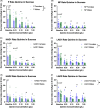Assessing initial/early aversion-resistant drinking across male and female alcohol-preferring and non-preferring rats
- PMID: 39725675
- PMCID: PMC11828967
- DOI: 10.1111/acer.15518
Assessing initial/early aversion-resistant drinking across male and female alcohol-preferring and non-preferring rats
Abstract
Background: One trait of alcohol use disorder (AUD) is continuing to drink despite negative consequences. The current study investigated initial/early aversion-resistant drinking (ARD) across selectively bred alcohol-preferring lines to assess aversion resistance with minimal ethanol history and subsequent ethanol-seeking and drinking profiles. Additionally, ARD was assessed in alcohol-preferring and non-preferring rats using a sucrose reinforcer to determine if ARD may be a genetic risk factor for AUD.
Methods: Male and female alcohol-preferring rats were given four concentrations of quinine (0.03, 0.10, 0.30, and 1.00 g/L-in random order) in an ethanol solution in the homecage for 30 min daily across 12 days. Seeking and drinking were then assessed in the operant chambers. Additional groups of alcohol-preferring and non-preferring rats were given access to the same concentrations of quinine-adulterated sucrose using the same daily, random-order presentation.
Results: In ethanol, all preferring lines performed similarly, showing resistance to quinine at the lowest concentration. In the homecage, high-alcohol-drinking (HAD)1 rats drank high levels of ethanol similar to alcohol-preferring (P) rats, whereas in an operant task were more similar to the HAD2 rats. In sucrose, P and HAD2 rats were shown to be aversion resistant at low concentrations of quinine compared to baseline. Overall, the non-preferring lines all demonstrated sensitivity to quinine-adulterated sucrose.
Conclusions: This study demonstrates alcohol-preferring lines show similar ARD when ethanol is the reinforcer. Regarding motivated responding, P rats show high-seeking and drinking behaviors as previously observed. In the homecage, HAD1 rats drink similarly to P rats indicating that different conditions (i.e., free vs. operant access) influence drinking behaviors between these lines. Importantly, in a sucrose reinforcer, alcohol-preferring rats are more aversion-resistant than non-preferring lines, while non-preferring lines show high sensitivity to aversion, suggesting an overall tendency to demonstrate a low level of compulsive behavior.
Keywords: alcohol; aversion‐resistant drinking; compulsive drinking; quinine; rat.
© 2024 The Author(s). Alcohol, Clinical and Experimental Research published by Wiley Periodicals LLC on behalf of Research Society on Alcohol.
Conflict of interest statement
The authors have no conflict of interest to report.
Figures






Similar articles
-
Crossed high alcohol preferring mice exhibit aversion-resistant responding for alcohol with quinine but not footshock punishment.Alcohol. 2022 Dec;105:35-42. doi: 10.1016/j.alcohol.2022.09.006. Epub 2022 Oct 20. Alcohol. 2022. PMID: 36272659 Free PMC article.
-
Alcohol-preferring P rats exhibit aversion-resistant drinking of alcohol adulterated with quinine.Alcohol. 2020 Mar;83:47-56. doi: 10.1016/j.alcohol.2019.09.003. Epub 2019 Sep 19. Alcohol. 2020. PMID: 31542609 Free PMC article.
-
Evaluating habit formation across pairs of female and male selectively bred alcohol-preferring and non-preferring rats.Alcohol. 2022 Aug;102:11-22. doi: 10.1016/j.alcohol.2022.04.003. Epub 2022 Apr 29. Alcohol. 2022. PMID: 35500755
-
The alcohol-preferring (P) and high-alcohol-drinking (HAD) rats--animal models of alcoholism.Alcohol. 2014 May;48(3):209-15. doi: 10.1016/j.alcohol.2013.09.044. Epub 2013 Oct 30. Alcohol. 2014. PMID: 24268381 Free PMC article. Review.
-
Phenotypic characterization of genetically selected Sardinian alcohol-preferring (sP) and -non-preferring (sNP) rats.Addict Biol. 2006 Sep;11(3-4):324-38. doi: 10.1111/j.1369-1600.2006.00031.x. Addict Biol. 2006. PMID: 16961762 Review.
References
-
- American Psychiatric Association . (2013) Diagnostic and statistical manual of mental disorders, 5th edition. Washington, DC: American Psychiatric Association. Available from: 10.1176/appi.books.9780890425596 - DOI
-
- Beckwith, S.W. & Czachowski, C.L. (2019) Ethanol pre‐exposure does not increase delay discounting in P rats, but does impair the ability to dynamically adapt behavioral allocation to changing reinforcer contingencies. Pharmacology, Biochemistry, and Behavior, 187, 172816. Available from: 10.1016/j.pbb.2019.172816 - DOI - PMC - PubMed
Grants and funding
LinkOut - more resources
Full Text Sources

